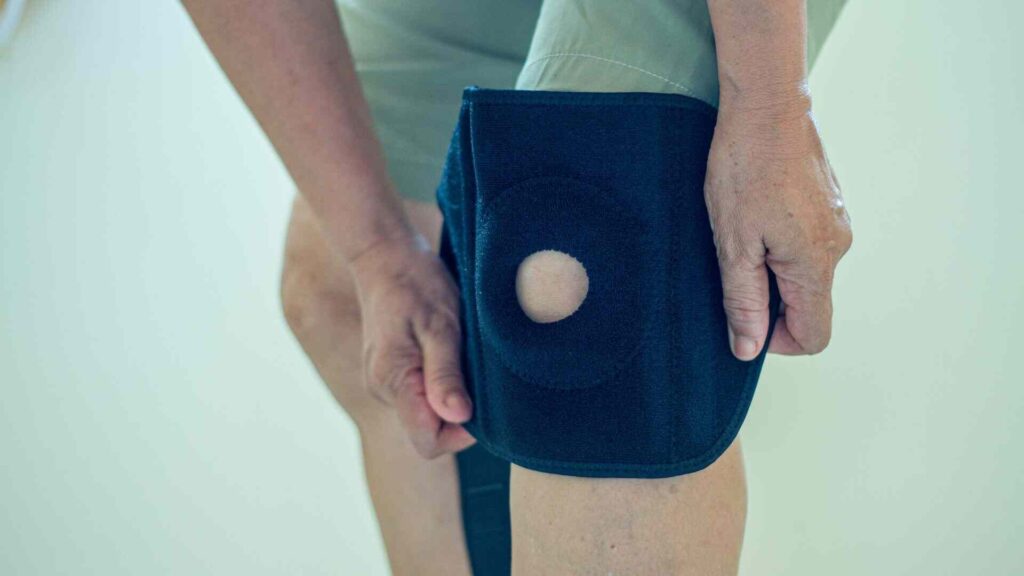Knee Support
Knee support refers to a special type of orthotic cushion that helps relieve knee pain by reducing the stress on the back of your knee and keeping it in proper alignment. Knee support cushions are made from EVA foam, gel and/or other materials designed to correct the alignment of your knee and help reduce inflammation.
Knee support cushions are designed to fit inside the back of your knee, providing the necessary support to help relieve pain and reduce inflammation. You can wear knee support cushions all day long, even while sleeping.
[lwptoc]
When should I wear knee support?
When your knee hurts, you should use a knee brace as support. Some people use them to guard against sports-related knee injury. Straps, foam, plastic, metal, or elastic materials are used to make braces. They come in a variety of shapes, hues, and patterns.
Is wearing knee support beneficial?
A knee brace can provide some stability and boost your confidence in your knee if worn regularly. According to some research, knee braces may help persons with knee osteoarthritis feel better and operate better. However, more subsequent research have found less of a benefit.
Which kind of knee brace should I purchase?
The one that best relates to you will decide the type of support you require. Knee supports have three major applications.
The first is to stop minor injuries from happening again during exercise by preventing, treating, and managing them. For instance, you could wear a supporting knee sleeve to prevent the flare-up of patellar tendinopathy (runner’s knee) if you have a history of the condition. This type of knee support will provide little support while maximizing flexibility, allowing you to continue moving normally. This kind of brace will be constructed from elastic yarn or a material similar to bandages.
After a catastrophic accident or surgery, knee rehabilitation is another frequent application for knee braces. A rather strong brace that protects the knee by restricting movement is required, for example, if you’re recovering from an anterior cruciate ligament (ACL) injury. To maintain the knee in position, these more supporting braces could incorporate foam, plastic, and metal components.

Thirdly, wearing a knee brace can assist people manage chronic illnesses like arthritis by easing their pain and inflammation. These braces must be more supportive than a simple sleeve support while yet being pleasant to wear for extended periods of time and flexible enough to not unduly restrict movement.
If you’re unsure about the type of knee brace that will work best for you or if you even need to wear one, see a health practitioner like your GP, physiotherapist, or pharmacist. Although a compression sleeve is unlikely to cause any serious harm, it is always advisable to seek professional counsel, particularly if the injury was brought on by twisting or impacting the knee. Consult a specialist immediately if your knee is swollen, you can’t fully straighten your leg, or the discomfort grows worse when you exercise. At worst, a brace might conceal an issue that other workouts could resolve.
Is a knee brace necessary?
While it’s unlikely to hurt to put on a basic compression sleeve to support your knee, it’s always worthwhile consulting a doctor if you’re worried about an injury enough to think about purchasing a support. This is especially true if the knee injury resulted by twisting it or being struck.
Consult a professional right away if your knee is swollen, you can’t fully extend your leg, or the discomfort in the area doesn’t go away or even gets worse when you exercise. Even if your pain is moderate and using a support helps, you should avoid wearing a brace for extended periods of time since you might be covering up a physical issue that might be resolved with other activities so that you don’t need to use a brace.
Do You Need A Knee Sleeve?
The kneecap literally grinds against itself as you lift a large thing and gradually raise the weight of the object. This approach frequently results in the development of progressive tendinitis. According to one survey, around 20 percent of Americans over 50 had artificial knees. This problem affects weightlifters and athletes significantly more frequently.
It’s crucial to understand that not all weightlifting exercises require knee sleeves. You can forego wearing them if you are not using your knees. However, you will need a knee sleeve to protect your knee if your routine involves squats, clean and jerks, or the snatch. In any situation where the knee is susceptible to harm, you run the risk of doing long-term damage.
Knee sleeves aren’t really necessary for people who are new to weightlifting; in fact, they can be a waste of money. Your knees won’t be under enough stress when you first start weightlifting to justify wearing a sleeve. However, depending on your age, skill level, and technique, your knees will be under greater or less pressure, requiring you to wear a sleeve.
You might benefit from a knee sleeve and a little more support because poor technique and form can have detrimental effects on your body. Problems could arise in as little as a year if this is not done.
Knee sleeves are a good support for anyone lifting in the intermediate or advanced range since they keep your entire knee in place and help you avoid more serious injury. Long-term strength gains and injury reduction are possible with the right equipment and technique.
Conclusion
Knee support cushions are available in different sizes, depending on your knee size. They can be worn with or without socks and are easy to clean. If you have knee pain, you should consult a doctor before trying any type of knee support cushion.
